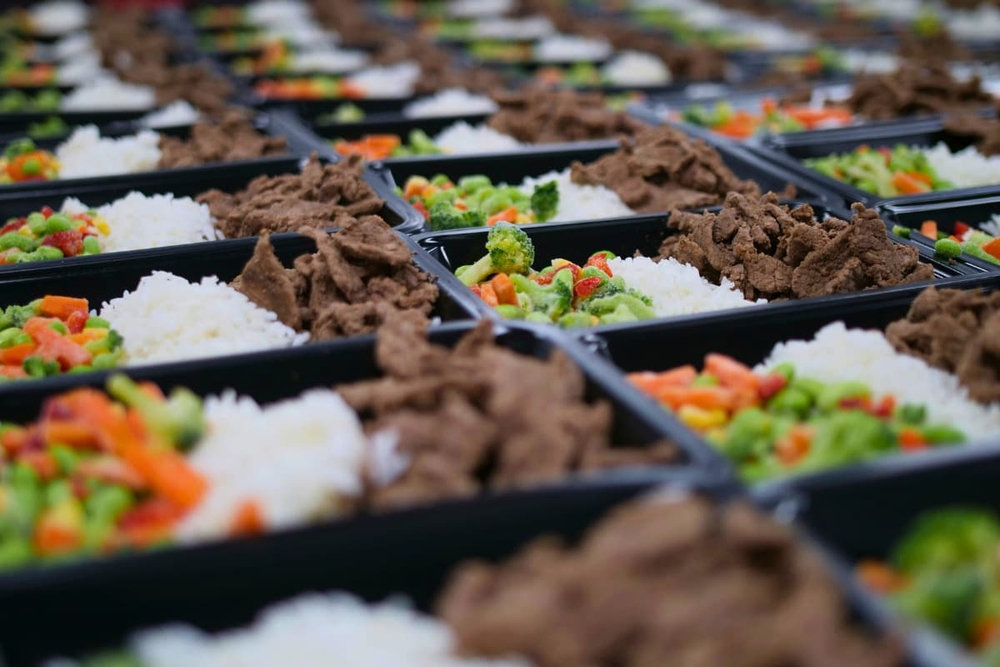How to streamline bulk food production operations for efficiency and growth
Table of Contents
CloudKitchens
How many tacos can be delivered from a 1000sqft restaurant?
The same amount as a 200sqft ghost kitchen.
In food production, efficiency and scalability can be paramount. Bulk food production, the process of preparing large quantities of food for distribution, presents unique challenges that require strategic planning and execution. Whether you’re serving hundreds of meal prep clients or supplying multiple restaurant concepts, managing large-scale production efficiently is crucial to profitability and customer satisfaction.
From implementing lean manufacturing principles to leveraging technology and training staff, we’ll delve into methods that can transform your food production processes.
Understanding bulk food production
Bulk food production refers to the preparation of large quantities of food at once, often in a centralized or commercial kitchen environment. This is common in meal delivery businesses, ghost kitchens, catering services, institutional kitchens (like hospitals or schools), and even some large-scale restaurants.
In these environments, production is not based on made-to-order meals but rather on batch cooking, assembly line processing, and advanced prep schedules. These businesses need to prioritize consistency, safety, speed, and cost control — all while delivering food that tastes fresh and high quality.
Read more: Overcoming food delivery challenges: Strategies for success
The key challenges of bulk production
Before jumping into optimization tactics, it’s important to identify what makes bulk food production difficult:
- Ingredient sourcing and waste management at scale;
- Maintaining food quality during mass preparation;
- Staffing and training across shifts;
- Equipment that supports large volume but requires regular maintenance;
- Compliance with safety and health regulations;
- Managing inventory to avoid spoilage or shortages;
- Forecasting demand and adapting to fluctuations.
These challenges make it clear that streamlined operations aren’t just a bonus — they’re a necessity.
Read more: Discover the benefits in how bulk food production boosts efficiency and profits
Strategies to Streamline Bulk Food Production Operations
1. Implement lean manufacturing principles
Lean manufacturing focuses on minimizing waste without sacrificing productivity. By adopting lean principles, food producers can identify inefficiencies and streamline processes. Key techniques include:
- Value Stream Mapping: Analyzing each step in the production process to identify and eliminate non-value-adding activities.
- 5S Methodology: Organizing the workspace for efficiency and effectiveness: Sort, Set in order, Shine, Standardize, and Sustain.
- Continuous Improvement (Kaizen): Encouraging ongoing, incremental improvements in processes.
Implementing these practices can lead to significant improvements in productivity and product quality.
2. Invest in the right equipment
In bulk operations, your equipment is either your biggest asset or a major bottleneck. Investing in high-capacity, energy-efficient appliances designed for continuous operation is non-negotiable.
Recommended equipment includes:
- Tilt skillets and steam kettles for large-batch cooking;
- Conveyor ovens or combi ovens for multi-rack throughput;
- Commercial blast chillers to rapidly reduce temperature after cooking;
- Automated packaging machines for meal prep and catering;
- Food processors, slicers, and portioning tools to reduce labor time.
According to the European Business Review, upgrading outdated equipment can increase production efficiency by 25–30% and reduce energy use.
Read more: Essential Guide to Industrial Kitchen Equipment for Ghost Kitchens
3. Optimize inventory management
Running out of ingredients mid-shift or letting food spoil on the shelf can cost you thousands. A centralized inventory system helps forecast needs, reduce waste, and ensure compliance.
Inventory software tailored to food service allows you to:
- Track real-time stock levels and usage trends;
- Automate reordering thresholds;
- Conduct accurate cost-per-serving analysis;
- Manage multiple storage zones (dry, refrigerated, frozen);
- Integrate with your POS or order management system.
Optimizing inventory ensures the availability of necessary ingredients while minimizing waste.
4. Leverage technology and automation
Technology can dramatically simplify bulk food production. Kitchen management systems, IoT-enabled appliances, and digital dashboards help centralize data and improve performance. You can consider:
- Smart kitchen sensors that track temperature or equipment uptime;
- Cloud-based order management systems to streamline workflows;
- AI-powered analytics to uncover inefficiencies in production;
- Mobile dashboards for managers to view real-time KPIs.
Nory.ai reports that connected kitchens using intelligent software see an average of 20% faster prep times and 15% labor savings.
Read more: Restaurant Technology: Boost your business with the best technology trends
5. Train and empower staff
Labor is a top expense, but also your most critical asset. In bulk operations, efficiency depends on having the right people in the right positions, trained to work quickly and safely.
Best practices include:
- Cross-training employees so they can cover multiple stations;
- Staggering shifts for prep, cook, and packaging to maximize facility usage;
- Conducting regular training on food safety, portion control, and SOP updates;
- Offering performance incentives tied to productivity or quality benchmarks.
Digital scheduling tools and performance dashboards can help track productivity and avoid understaffing or overtime. Empowered employees are more engaged, productive, and capable of maintaining high-quality standards.
Read more: The ultimate guide to training your kitchen staff for speed and accuracy
6. Implement quality control measures
Safety and compliance aren’t optional, especially when dealing with bulk quantities. In large-scale operations, the risk of contamination or spoilage increases if protocols are not followed precisely.
Implement safety best practices:
- Train all staff in local food handling certifications;
- Use HACCP (Hazard Analysis and Critical Control Points) plans;
- Monitor and log cold storage and cooking temps;
- Rotate stock using FIFO (first-in, first-out) methods;
- Sanitize shared surfaces and equipment regularly.
CloudKitchens facilities, for instance, are built to meet local health department requirements, and many offer ongoing support with compliance and inspections.
7. Design efficient kitchen layouts
An optimized kitchen layout enhances workflow and reduces bottlenecks. Considerations include:
- Process Flow: Arranging equipment and workstations to follow the sequence of production steps.
- Space Utilization: Maximizing available space for storage, preparation, and cooking.
- Safety and Accessibility: Ensuring clear pathways and easy access to equipment and ingredients.
A well-designed kitchen promotes efficiency and safety in food production.
Streamlining operations for scale and quality
Bulk food production doesn’t need to be chaotic or inconsistent. By investing in the right equipment, software, staff training, and process optimization, your operation can scale smoothly — while maintaining the quality and safety your customers expect.
Every minute saved, every ounce of food preserved, and every process standardized adds up to higher profit margins and stronger customer loyalty.
If you’re ready to grow your bulk production business, CloudKitchens offers the infrastructure, support, and flexibility to help you scale fast. Our facilities are designed for high-volume cooking and food prep, whether you’re a ghost kitchen, catering brand, or meal delivery company.
Contact CloudKitchens today to explore how our kitchens can streamline your bulk production and fuel your growth.
DISCLAIMER: This information is provided for general informational purposes only and the content does not constitute an endorsement. CloudKitchens does not warrant the accuracy or completeness of any information, text, images/graphics, links, or other content contained within the blog content. We recommend that you consult with financial, legal, and business professionals for advice specific to your situation.
More insights & stories
There’s more where that came from.
Get in the know and check out our additional insights


